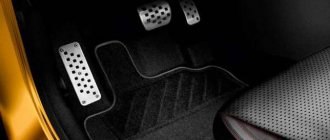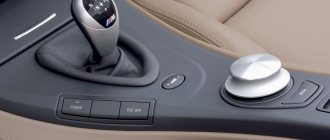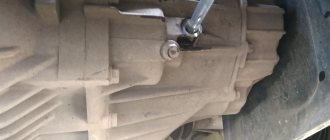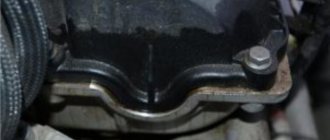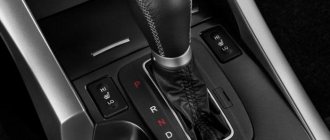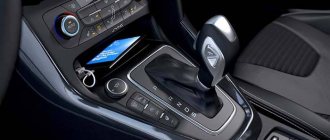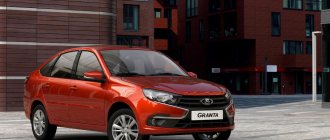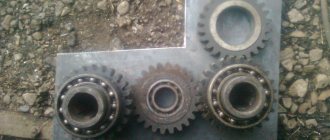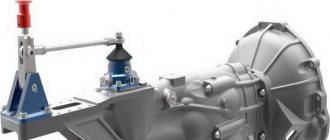Types of automatic transmission | Types of automatic transmissions
Drivers of cars equipped with a manual gearbox, from time to time, in order to engage the desired gear, have to control the car using only one hand.
In contrast, happy owners of vehicles with an automatic gearbox can hold the steering wheel with both hands throughout the entire movement. And now we will look at the basic types of automatic transmissions. Summary :
Operating modes
Operating modes are indicated in the form of alphabetic symbols so that the driver can react to driving conditions:
- D – classic forward movement;
- R – reverse gear of the car, which should be engaged when the driver holds the brake pedal;
- N – mode when the gearbox and engine are disconnected, which is called neutral;
- S – mode, which is necessary when the car is moving on slopes, while the low gear mode is activated.
Types of automatic transmission | Types of automatic transmissions
Classic hydraulic “Automatic” (automatic transmission) | Hydraulic automatic
Unlike a manual gearbox, a hydraulic “automatic” requires slightly more fuel and takes longer to accelerate. But this is the price you have to pay for comfort. And it was “hydraulics”, challenging “mechanics”, that won a landslide victory in many countries, except for “old Europe”.
How does an automatic transmission work?
For a long time, drivers in Europe categorically rejected types of automatic transmissions Engineers had to do a lot before finally adapting the automatic gearbox for Europe. But all this ultimately served to increase efficiency and the emergence of such modes as “winter” and “sport”. In addition, the box learned to adapt individually to the driver’s driving style, and it became possible to manually change gears with an automatic transmission - which was important for European drivers.
Each manufacturer preferred to call such transmissions differently, but the very first name to appear was Autostick. One of the most common inventions today is considered to be the invention of AUDI - Tiptronic. BMW, for example, called such a transmission Steptronic, while Volvo considered it a suitable name for the Geartronic automatic transmission.
However, even though the driver engages the gears himself, he is not considered to be completely manual. This is more semi-automatic, because the transmission computer continues to control the operation of the car regardless of the selected mode.
Robotic gearbox | Automatic robot
MTA (Manual Transmission Automatically Shifted) - or the so-called DSG robot, is structurally, perhaps, in many ways similar to “mechanics”, but from a control point of view, it is nothing more than an automatic transmission.
And although fuel consumption here is more moderate than with the same manual transmission, there are also some nuances. The “robot” is very effective only at a very moderate driving pace. The more aggressive your driving becomes, the more painful the gear changes feel. Sometimes when switching, it may even seem as if someone is pushing you into the rear bumper. That is, the difference between a robot (DSG) and an automatic machine lies in the principle of operation of the former. However, the low cost and low weight of the automatic transmission completely compensate for this disadvantage.
About the DSG box Video
Why does Robot need two clutches?
Volkswagen Golf R32 DSG with 2 clutches
Existing shortcomings seriously complicated the operation of the robotic transmission, which especially affected the comfort of movement. Therefore, the designers, during a lengthy “search”, eventually came to a solution that solved the problems - they equipped the “robot” with two clutches.
In 2003, Volkswagen launched a robotic transmission with two clutches into mass production, installing it for the first time on the Golf R32. It was named DSG (Direct Shift Gearbox). Here, even gears were controlled by one clutch disc, and odd gears by a second. This significantly softened the operation of the box, but another serious drawback appeared - the price of this automatic transmission is quite high. Although mass acceptance of such a transmission by car enthusiasts can solve this problem.
CVT | CVT gearbox
CVT | Continuously variable transmission
Useful video about what a CVT transmission is
Features | Differences between a CVT and an automatic transmission.
Those drivers who are accustomed to “listening” to their car will not be able to love such a box, because, like a trolleybus, a CVT automatic transmission does not change the tone of the engine. But it’s probably not worth abandoning the CVT for this reason. Engineers found a way out of this situation by adding a mode where “virtual gears” can be selected manually. The gearshift mode is simulated, allowing the driver to experience driving like a conventional automatic gearbox.
How to determine which gearbox is installed in a car, CVT or hydraulic automatic:
What is more reliable and better: a CVT, a robot or an automatic?
Source
Main disadvantages of automatic transmission
- "Classical"
- High cost of production, which affects the price of the car as a whole.
- Compared to mechanics, the risk of breakdown is higher.
- The dynamic properties of a car and its efficiency directly depend on the success of a particular modification of the box and the year of its creation. Boxes of early releases increased fuel consumption and reduced dynamics.
- It is absolutely impossible to start the car “from the pusher”, since it requires mass pressure in the system and a working oil pump.
- Robot boxes
- When driving aggressively, driving discomfort occurs.
- Preselective boxes are more expensive than any other.
- Not resistant to slipping.
- At the beginning of the movement, you need to be prepared for a rollback.
- Gear shift delays often occur.
- Doesn't work correctly if you make mistakes while driving.
- Lower resource than the “classic” type.
- When transferring from another type of gearbox, an adaptation period and a process of adjusting your driving style may be required.
- CVT
- High cost of production.
- Expensive repairs and maintenance.
- Compared to hydraulics, maintenance needs to be done twice as often.
- Low resource of the main mechanism of the variator, 120 thousand kilometers.
- Does not fit well with powerful and large engines, more powerful than 200 horsepower. Belt (chain) wear increases.
- May not work correctly in cases of slipping or overheating.
- There may be problems with the computer system that controls the transmission.
In general, we can say that the choice of automatic transmissions provides car enthusiasts with the opportunity to choose a box to suit their car and driving style. For owners of cars with an eye on high mileage, the hydraulic option is suitable. Drivers of budget small cars and sedans get a CVT. And for sports-class cars, a dual-clutch robotic gearbox would be an ideal option.
Hydromechanics
A hydromechanical automatic is the most common type of automatic transmission, found in almost all automakers. Due to their design features, these machines handle high torque better than others, which is why they are most often installed on heavy crossovers and SUVs, as well as on full-size sedans. Essentially, this is a planetary gearbox connected to the engine through a torque converter. Switching of planetary gears in early models occurred hydromechanically, and now - according to electronic commands.
Budget models are equipped with simple “four-speed” gears, although there are few of them left. For example, the popular DP0/DP2 gearbox works on many inexpensive Peugeot-Citroen and Renault models. The performance of this box is not the best, as is its reliability: as a rule, it lasts no more than 120,000 km. The Japanese Jatco four-speed gearboxes are much better in terms of reliability (about 200,000 km), and even better in terms of switching algorithm. They are installed on Grants and Datsuns.
Constantly tightening emissions standards are forcing manufacturers to increase the number of gears in automatic transmissions. But not only nature benefits from this, but also car owners: multi-stage gearboxes make it possible to optimally realize the engine’s capabilities and thus reduce fuel consumption. Even relatively inexpensive cars, for example, Kia Rio or Hyundai Solaris, now use six-speed automatic transmissions. The 09G Tiptronic gearbox installed on the Volkswagen Polo and Skoda Rapid models has the same number of gears. The average resource with careful operation and timely replacement of the working fluid (at least every 60–80 thousand km) is 250,000 km.
On more powerful and heavier cars, the number of stages in automatic transmissions can reach up to ten (for example, in the Chevrolet Camaro ZL1 coupe and Ford F‑150 pickup truck). But “multi-stage” affects reliability. After all, the more gears, the more often the box shifts, which means the more friction clutches wear out. In addition, strict restrictions on dimensions lead to the fact that each stage becomes smaller (without a significant margin of safety).
A universal (and best) solution for the city and off-road - hydromechanics
Robots
Robots can be divided into two groups. A robot with one clutch is a regular “mechanics”, in which the clutch and gear shifting are controlled not by the driver, but by automation. In theory, the reliability of such a unit should be the highest among automatic transmissions. But practice does not confirm this. For example, the editorial Vesta with the robot already had three clutches with a mileage of less than 45 thousand km. The Easytronic box, which was installed on Opel, tormented its owners with electronic failures. In terms of speed and shifting comfort, a single-clutch robot is the worst automatic transmission. Its main advantage is its low price. Therefore, it is installed mainly on small and inexpensive cars.
A robot with two clutches is more complex and expensive. Separate input shafts and, accordingly, separate clutches are responsible for even and odd gears in such a box. If you, for example, are moving in first gear, then second gear is already engaged on the other shaft! Thanks to this, switching occurs in milliseconds and jerks are not felt.
In such boxes, both dry and wet clutches can be used. Dry ones are less reliable - sometimes they have to be changed after a mileage of 30,000 km; they rarely reach 100 thousand. “Wet” DSGs produced by the Volkswagen concern have a tolerable service life - about 150 thousand km and even more with careful driving.
Ford Powershift robots with dry clutches are not distinguished by either smooth operation or long service life. Therefore, Ford is gradually abandoning gearboxes of this type, preferring classic automatics.
But the Koreans, on the contrary, seem to be ready to promote robots - the 7DCT gearbox is increasingly being prescribed on new Kia and Hyundai models.
Source
How to distinguish a robot from an automatic or CVT
The fact is that manufacturers strive to simplify as much as possible the entire process of interaction between the driver and the gearbox. For this reason, for example, a robot may have the same selector and modes (PRND) as a CVT or automatic transmission.
As for the driving sensations (provided that the transmission and the car itself are in full working order), you can pay attention to the following:
- in the case of a “classic” automatic machine and preselective robots in mode D, a slight push may be felt;
- on the variator the moment of switching is not felt;
- a single-disc robot can shift relatively smoothly at low speeds in quiet mode, but during dynamic driving the box begins to push harder.
We also recommend reading the article about what an automatic transmission selector is. From this article you will learn about the different types of automatic transmission selectors, as well as what features and differences in the implementation of the automatic transmission selector can be found on different types of automatic transmissions.
For this reason, it is recommended to study the vehicle manual separately to determine exactly what type of transmission is installed on a particular model. In general, pay attention to the following instructions:
- AT - often means hydromechanical automatic;
- CVT - variable speed transmission;
- AMT - robotic gearbox with one clutch;
You can also visit specialized auto forums, study technical literature separately, etc.
Types of automatic transmissions
There are three most common types of automatic transmissions that are installed in cars - the so-called “classic”, also known as hydraulic, robotic (robot, tiptronic) and variable (variator, CVT).
"Classic" automatic transmission
This is the first type of box to appear. It is distinguished by the complete absence of any connection between the engine and the wheels. Consists of a torque converter (HT), gear and planetary gears. The gear ratio changes by changing the oil pressure and different connections between the gears. Automatically controlled.
There are 5 main operating modes of this unit:
Reference! These are the main operating modes that are necessarily present in all hydraulic automatic transmissions. In addition to them, depending on the manufacturer, there are additional modes that make driving easier in different conditions.
Robotic automatic transmission
The latest type of automatic transmission to appear. At its core, it is a manual gearbox controlled by a robot, which, in accordance with specified algorithms, disengages the clutch and changes gears. That is, the driver and vehicle provide only input data without influencing the gear shift mechanism.
Robots for such boxes are either electric or hydraulic. Hydraulic ones operate using hydraulic cylinders controlled by electromagnetic valves. They are quite fast, but more energy-consuming. This is the main type of robot for sports cars.
Electric robots are slower but more economical. They use servomotors and various mechanisms in their work. Most often installed on budget cars.
The gearbox itself is mechanical with a friction clutch. There are robotic gearboxes with single and double clutch.
Reference! You can easily distinguish the robot from the “classics” by the absence of the P sign on the robot, which means parking mode.
Variable speed drive
The second name by which you can determine the type of transmission from the car documentation is CVT (Continuously Variable Transmission). It works on the principle of smooth transmission of torque from the engine to the wheels. There are no gears as such, and the gear ratio changes either fully automatically, in accordance with a given program, or manually.
The most common boxes are those with a V-belt variator structure. The change in gear ratio in them is transmitted between two pulleys, each consisting of two conical parts, using a special belt. A belt is also called a chain due to the fact that its main component is metal strips. The pressure necessary for the movement of the cylinders is pumped up by an oil pump, which pumps a special ATF fluid, which also acts as a lubricant.
The second type of variator is toroidal. In this case, the force is transmitted through toroidal rollers, sandwiched between the shafts and located on the same axis. This type is used quite rarely.
This automatic transmission has the ability to switch to manual control mode. In this case, the driver changes gears independently and this is displayed on the dashboard. But you shouldn’t expect that it will be possible to keep the number of revolutions in the red zone - the automation simply does not allow you to do this, but it is also impossible to stall if there is a lack of them.
Main advantages of automatic transmission
- "Classical"
- The hydraulic automatic transmission has a high service life (from 120 thousand to 1 million kilometers), which allows it to last the entire service life of the vehicle.
- Much superior to a manual transmission in terms of efficiency and shift speed.
- It is considered the most comfortable of transmissions, thanks to the smoothness and imperceptibility of shifts. At the same time, the engine operates in a wide range of speeds without creating acoustic fatigue.
- It survives slipping while driving without any problems.
- There is no rollback at the moment of starting movement from a standstill.
- Works equally well at any speed.
- Due to the lack of connection with the engine, shocks and vibrations are not transmitted to it, which increases its overall resource.
- It is possible to effectively use engine braking.
- Additional modes significantly expand the ability to drive a car in various situations and climatic conditions.
- Robot boxes
- Cheap production.
- Speed changes are the fastest.
- Economical.
- CVT
- Always optimal engine operating mode.
- Provides maximum driving comfort - no jolts, delays, or jerks. The car accelerates well.
- More economical than a hydraulic automatic transmission.
- Fairly simple design.
Technical characteristics of automatic transmissions, types and their differences from each other
The other day a friend approached me with a question about what type of automatic transmission to choose. He is going to buy a car, but he does not understand modern gearboxes and does not know which one is better for driving in the city and on off-road areas. I, of course, explained to him the advantages and disadvantages of different types of machines.
I sit and think, but those who read my articles also suffer from a choice. So I decided to write a review on gearboxes that are used in modern vehicles.
How to drive an automatic transmission, and what not to do?
Rules for driving a vehicle:
- Press the brake pedal all the way, moving the selector lever towards D.
- The driver must then release the car's handbrake.
- If the driver smoothly releases the brake pedal, the car begins to move forward.
- In order to increase the speed limit, you need to press on the gas, the box will independently select the required operating mode. To reduce speed, you need to release the gas pedal.
- If you need to stop the car, you should press the brake.
- The selector lever must be in position D regularly while driving.
Type of automatic transmission and principle of operation
Write in the comments what kind of automatic transmission do you have in your car? How did you come to your choice? Did a friend advise you or are you an experienced mechanic yourself?
So, let's talk about the types of automatic transmissions. There will be only three of them. But each type of machine has additional variations. I placed a short description and type of box in the table for initial reference.
| Automatic transmission type | Variations |
| Classic slot machine | |
| Variable speed drive | V-belt Toroid |
| Robotic box | Hydraulic Now let’s see what the difference is between these gearboxes, how they differ, and which one is most suitable for traveling to the village to visit grandma or for driving around the city.
Traditional version hydraulic automaticThis type of box is the very first to appear among the others. The debut model was made in the 30s of the twentieth century. Every decade, automatic transmissions have been modernized and improved. The main feature of the machine is the lack of connection between the wheels and the engine. Torque is transmitted through a pump wheel and turbine, which push transmission fluid, which creates pressure. The automatic transmission consists of the following components: Previously, these boxes had only 4 gear stages, now there are six-speed and eight-speed automatic transmissions. In the last century, the machine was programmed for only five operating modes. The following features have now been added: Now there are automatic transmissions with adaptation. Such machines independently adapt to the driving style of the car owner. We looked at the characteristics of the automatic transmission. It is important for you to find out what the advantages and disadvantages of these types are. Let's take a look at them too. Pros of hydraulic automatic transmissionThe advantages of an automatic transmission are as follows: Just as each type has its pros, there are also cons for different types of automatic transmissions. Disadvantages of hydraulic automatic transmissionNegative aspects of this type of automatic transmission: There are also disadvantages in terms of technical parameters. These include shortcomings of manufacturers, childhood diseases of this type of automatic transmission.
CVT boxYou've probably come across the name CVT. The abbreviation stands for “Continuously Variable Transmission”. And translated into Russian it means the following – “continuously variable transmission” or CVT. A CVT is also one of the types of automatic transmissions. It differs from a hydraulic transmission in its structure and fixed number of speeds. The variator shifts smoothly, the driver does not feel even slight jolts, as with an automatic transmission. This type of box always maintains a balance of speed and picks up gear changes at the right moment. Works constantly in a monotonous mode. For those who like to hear their car, a sharp increase in speed is not suitable. This is a delicate box and requires careful handling. CVTs can only be used on smooth roads, city roads or highways. The design of this type of automatic transmission is as follows: There are two types of variators. These are V-belt and toroidal. The difference between a V-belt and a toroid is that in the first, two pulleys with a belt change the gear ratio. On a toroidal one, speeds are switched by toroidal rollers, which are sandwiched between shafts on the same axis.
Pros of a CVTThe advantages of a CVT automatic transmission include: We will consider the disadvantages of this type in the next block. Disadvantages of a CVTThe negative aspects of this type of automatic transmission include expensive maintenance, as well as: If you choose the type of CVT box, then rest assured that it is capricious. But for those who like a quiet ride, don’t go on picnics, and need a car as a means of transportation from work to home, then a car with this automatic will be an ideal friend. Robotic transmissionThe types of automatic transmissions don't end there. There is another type - this is an automated gearbox (AMT). This manual transmission differs from the one of the same name only in that the computer controls the gear shift.
The first types of robots came out “crooked.” Car owners have constantly complained that when accelerating they feel as if someone is pushing them into the bumper. There was no comfort when driving a car equipped with such a transmission. Therefore, the designers redesigned the automatic transmission and in 2003 the German company Volkswagen released a robot with two turbines. Here the turbines act as a clutch. The name of such a robot was given “DSG”. Now the even gears were controlled by one disk, and the odd ones by the second. When the gear was shifted to even, the odd one was already ready to shift to the next speed. This type of design made it possible to achieve smooth switching. There are two types of robotic gearbox: hydraulic and electric. Hydraulic ones operate using hydraulic cylinders and electric valves. Such boxes are installed mainly on sports cars. The electric type of robotic automatic transmission is itself slow and economical. Servo drives are used for operation. Installed on budget cars. Despite all the changes in the design of the DSG varieties, the symptoms of the disease still remained and remain. And the price of the latest update to the robot’s automatic transmission has skyrocketed. Pros of the robot boxThe advantages of robots are as follows: In principle, that’s all the advantages of robotic boxes. This is not a very reliable type of automatic transmission; many car owners do not like robots. But maybe in the future it will be able to be brought to a new stage of development. Cons of the robot boxThere are more negative sides: All these listed and not listed features make the robot more capricious than a CVT. But I know people who like the robot. Therefore, it’s probably worth getting used to driving with it.
|
Torque converter
Torque converter
It replaces the standard clutch for a manual transmission, and is also located between the gearbox and the engine, attached to its flywheel. Its main task is to smoothly change and transmit torque to the drive shaft of the automatic transmission. Its design includes such elements as: pump, turbine, reactor wheels, freewheel and locking clutch. The pump wheel is attached to the torque converter housing and rotates with it. The turbine wheel sits on the drive shaft of the planetary gearbox. Each wheel has blades of a certain shape; when the engine is running, the working fluid with which it is filled begins to pass between them.
As soon as the engine starts, the pump wheel begins to rotate and its blades pick up the working fluid, directing it to the blades of the turbine wheel, from which it flies off to the reactor wheel (reactor) located between them. The reactor directs the flow of returning liquid towards the direction of the pump wheel; two forces begin to rotate it, due to which the torque increases. When the revolutions of the pump and turbine wheels are compared, the freewheel is activated and the reactor begins to rotate due to it, this moment is called the clutch point. After this, the torque converter begins to work as a fluid coupling, rotation from the engine begins to be transmitted to the drive shaft of the planetary gearbox through the working fluid. The exception is the Honda automatic transmission, where instead of a planetary gearbox, shafts with gears are installed, just like on a manual transmission.
We recommend: What compression should be in a gasoline and diesel engine
But 100% of the energy is still not transferred from the engine due to viscous friction of the oil. To eliminate these costs and use it as efficiently as possible, which ultimately leads to a reduction in engine fuel consumption, there is a lock-up clutch that engages at about 60 km/h and more. This coupling is located on the turbine hub. As soon as the car reaches the required speed, the working fluid enters the wall of the locking clutch on one side, and on the other it approaches after the channel is opened by the switching valve, thereby creating a low pressure zone. Due to the pressure difference, the locking piston is activated, at this moment it is pressed against the torque converter housing, as a result of which the clutch begins to rotate with the torque converter housing.
Methods for determining the type of automatic transmission
I told my friend about the boxes. And he asks: “So what is their difference? I can’t tell right away.”
Let's talk about the differences:
Read the manual, collect information on the Internet about the box with which you want to purchase a car. Now manufacturers are trying to make gear selectors for different types of automatic transmissions that look similar to each other.
Write in the comments if you can determine which box is in front of you?
What to choose
Then my friend says: “Okay, I figured out how to distinguish them. What type of automatic transmission would you recommend? Everyone has their pros and cons.
I'll say this. For urban driving, buy a car with a CVT. If you prefer to drive a car around the city, and on weekends out of town for picnics, then take a hydraulic automatic. If you like to race, then a hydraulic robot is perfect. Just keep in mind that a good robotic box will be expensive.
Like and share information on social networks. Write in the comments what else you would like to read about.
Read
What is the difference and how does a robotic gearbox differ from an automatic transmission?
